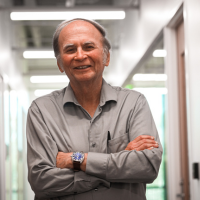
Tulane University │ New Orleans, Louisiana
For designing a method based on quantum mechanics that is widely used by researchers to computationally predict physical properties of atoms, molecules, fluids, and solids.
Understanding how electrons interact within atoms, molecules, and solids has been a central challenge of modern physics and chemistry, especially as scientists increasingly look to metamaterials as a potentially transformative technological frontier. Metamaterials are engineered structures, materials designed at the molecular level to exhibit properties not found in nature, that could revolutionize fields ranging from telecommunications to energy to biomedicine. Achieving the precise understanding necessary to create these novel materials hinges critically on the ability to model electron motion accurately.
Theoretical physicist John Perdew has devoted his career to refining one of the most powerful tools for investigating the electronic structures of materials: density functional theory (DFT). Through his groundbreaking improvements to density functionals, Perdew has enabled researchers worldwide to explore materials and chemical phenomena with unprecedented precision. His work has been cited 440,000 times according to Google Scholar.
Perdew developed an early curiosity about how the world works at its most fundamental level. That curiosity guided him toward physics, a path he followed from Gettysburg College, where he earned his bachelor’s degree, to Cornell University, where he completed his Ph.D. in 1971. Perdew’s deep knowledge of theoretical physics enabled him to make breakthrough developments at a pivotal moment in the evolution of computational methods.
While quantum mechanics had long provided the basis for understanding electronic structure, it remained a major undertaking to calculate properties of real materials composed of large numbers of interacting electrons. While the equations of quantum mechanics proposed by Schrödinger allowed physicists to make predictions for systems with a few interacting electrons, these calculations require large computer resources and cannot be extended to much bigger systems.
Seeking a solution, Perdew found himself increasingly drawn to the possibilities of density functional theory. First proposed in 1927 and proved by Hohenberg, Kohn, and Sham to be a rigorous theory in the 1960s, DFT captured the attention of physicists and chemists by offering a more computationally efficient way to investigate electronic structures. Rather than tracking every electron’s motion individually, which would require a many-electron wavefunction in a high-dimensional space, DFT uses the overall electron density in just three dimensions. The energy formula of this method includes, however, a term called the "exchange-correlation energy," whose exact form is un-computable and must be approximated. This term describes correlations of electron-electron motions. Similar to how dancers influence each other's movements on a crowded dance floor, electrons affect one another through their electric charges, subtly altering each electron's path and energy. Exchanges of electrons are similar to changes of partners in mixed dances. The challenge of accurately describing these interactions within the DFT framework made the first DFT approximation accurate only for metals, a small percentage of materials. Developing robust approximations for electron-electron correlations and exchanges would become central to Perdew’s career.
Before Perdew entered the field, DFT employed the local density approximation (LDA), with inputs that dated to 1930. Researchers recognized this shortcoming and developed more refined methods incorporating density gradients. However, all such methods initially proposed performed worse than LDA.
It was Perdew who with David Langreth discovered the reasons for the poor performance of early gradient expansions and developed methods to cure these problems. This effort resulted in methods called the generalized gradient approximation (GGA), leading to more accurate descriptions of electron interactions than in the case of LDA. The widely used Perdew-Burke-Ernzerhof (PBE) functional, introduced in collaboration with Kieron Burke and Matthias Ernzerhof in the 1990s, became a cornerstone for computational physics and chemistry. PBE’s balanced approach offered enhanced accuracy while maintaining computational feasibility, quickly becoming the standard for modeling electronic structures. With Mel Levy and other collaborators, Perdew discovered many unexpected mathematical features of the exact density functional for the exchange-correlation energy, including some which he and others built into PBE and later approximations.
As computational resources expanded, Perdew and collaborators continued pushing boundaries, guiding the development of meta-GGA functionals. These advanced functionals incorporate additional information, such as electron kinetic energy density, enabling even greater precision in describing chemical bonding and electronic properties, particularly in challenging materials.
Throughout his distinguished academic career at institutions like Tulane University, where he began his teaching career in 1977 and returned to in 2023, and Temple University, where he taught from 2013 to 2023, Perdew has mentored numerous researchers who have themselves become influential in quantum theory. His teaching emphasizes clarity, precision, and meticulous reasoning, reflecting his rigorous approach to scientific discovery. His 50-year career has resulted in many honors, including the John Scott Award, the MRS Materials Theory Award, and election to the National Academy of Sciences.
Perdew’s work transcends the realm of the academic community, giving both academic and industrial researchers a viable method for pursuing metamaterials, as well as impacting industries ranging from pharmaceuticals to renewable energy and electronics. By systematically improving density functional theory, Perdew has transformed theoretical concepts into practical, powerful tools that drive innovation across science and technology. His ongoing efforts continue to address unresolved issues, like strongly correlated electron systems, ensuring DFT remains robust, relevant, and indispensable for future discoveries.
John Perdew’s enduring legacy illustrates the profound impact that careful, incremental refinements of scientific theories can achieve, underscoring his role as one of the great minds in theoretical physics and computational materials science.
Information as of April 2025.

